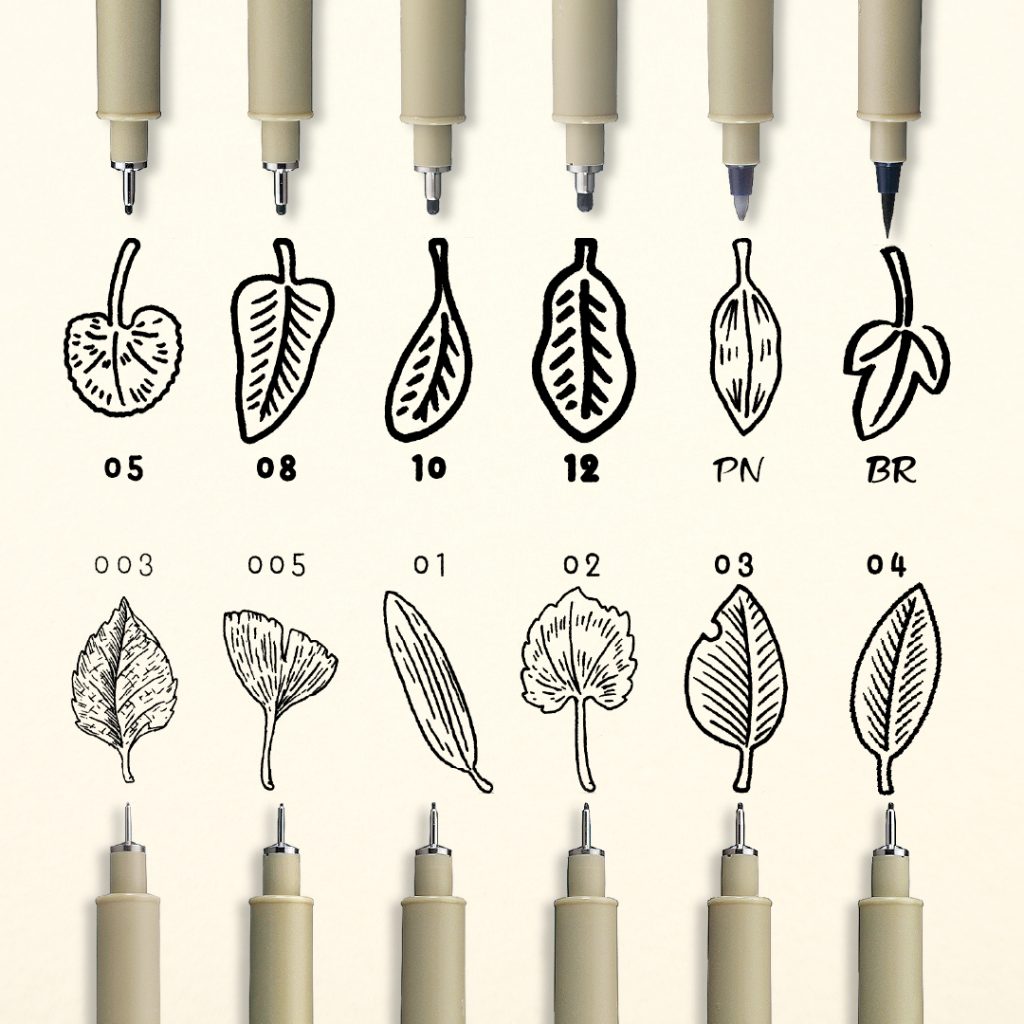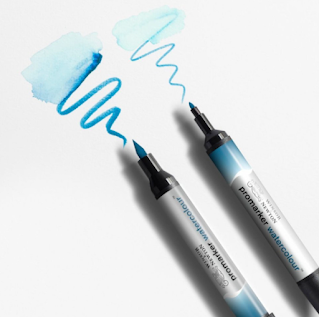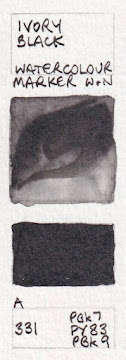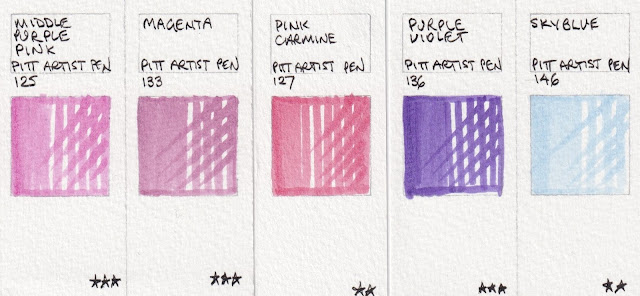I've often written about fountain pens, which I have always loved for their feel, their performance, their permanence and so on. However I also use felt-tip pens and they can be very useful for writing or sketching due to their convenience.
I write a lot. I keep a journal that I update periodically; I use a paper diary that I use to plan and record all that I am doing in a day, a week, a year; I use a notebook for the French lessons I do every day; I use sketchbooks to record my explorations, and I write letters! For many of these tasks I use a fountain pen, but for some I also use coloured felt-tip pens for headings or, in my French lessons, for the English to make the translations clear. I change the colours each new topic, and work with 0.1 and 0.5 sizes for bolder headings and finer body writing. While I could empty the colour from a fountain pen and change it, grabbing a coloured felt-tip pen is very convenient.
I also use them to draw. While most of my sketching is done with fountain pens and document ink, once I have added a watercolour wash over a sketch I often use a felt-tip pen rather than the fountain pen to add more details. These will also be pigmented and waterproof. I have worked with quite a few brands, which I'll share here. There are many others that I won't mention as I haven't compared all brands.
My first choice tends to be
Sakura Pigma Micron pens, and creating this blog post and the YouTube videos that add to it, that choice has been further cemented. These were launched in 1982 and were the world's first pigments fine-liner pens. Made from pigmented ink, they are lightfast, waterproof, fade resistant, odorless and they seal well with a 'click'. These come in a range of colours, nib shapes and sizes and though I do prefer pens that are not disposable, I have had some of these almost as long as they have been available and they are still going strong so they really do last.
Here is an exploration I did as part of my Travel Sketching course. The information was about sketching pens, so I concentrated on black, brown, grey and sepia. However in researching this subject, I wanted to go into even more depth about exactly what colours are available, and in what sizes.
 |
| Pigma Micron writing samples in Black, Greys, Brown and Sepia. |
In Black, the Pigma Micron is available in 10 sizes. All but the 003, 10 and 12 are shown above.
- 003 = 0.15 mm
- 005 = 0.20 mm
- 01 = 0.25 mm
- 02 = 0.30 mm
- 03 = 0.35 mm
- 04 = 0.40 mm
- 05 = 0.45 mm
- 08 = 0.50 mm
- 10 = 0.60 mm
- 12 = 0.70 mm
 |
10 nib types, from Sakura marketing.
|
Pigma Microns are also available in an additional 16 colours. Not all colours are available in all sizes, though all are available on 05. The most common nib sizes for the colours are 005, 01 and 05.
There is also a Pigma Brush Pen available in 11 colours, and a Pigma PN range available in 8 colours.
This graphic from the Craypas website shows the tips sizes of the Microns, Brush pens and PN pens clearly, along with the range of lines they can create.
 |
| The Pigma PN nib up close, from Larrypost.com.au |
The PN has a different tip made with plastic, that is more robust than the traditional felt-tip of the Pigma Microns. You can use pressure and a change of angle to vary the lines created. Here is a terrific view of this pen tip from
Larrypost.com.au in Australia. The PN tip can be used to make the lines that vary from almost as small as the 0.05 if you use extremely light pressure, up to about 0.6 with a change of angle and pressure. The shape makes it more comfortable for writing for many people than the traditional felt-tip.
 |
Pigma Micron pen colours (from Sakura marketing - Craypas website)
|
The Pigma colours are Yellow, Orange, Red, Burgundy, Rose, Purple, Blue, Royal Blue, Blue Black, Green, Hunter Green, Fresh Green, Brown, Sepia, Light Cool Grey and Cool Grey. They can all be seen in the excellent promotional graphic from the Sakura marketing.
 |
| Some of my Pigma Micron coloured pens. |
Below is a chart showing which colour pens are available in which size. As I don't have them all, not all are completely filled in, but the box represents that the pen is available in that size and colour. Yellow, Royal Blue, Hunter Green and Fresh Green are only available in the 05. Burgundy and Blue Black are available in the 05 and the PN. There is also a set of nature colours that includes these newer colours.
 |
| The Sakura Pigma pens in the Pigma, Brush and Micron ranges. |
The PN (Plastic Nib) is available in 8 colours - red, burgundy, rose, purple, blue, sepia, blue black and black.
The Pigma pens write smoothly and feel 'wet' enough to flow well. The colours are bright and clear, and come in a great range. As they are lightfast and waterproof, they can be used for professional art works. I have used them for decades and recommend them for writing and drawing. I'll say again though that the main sizes I use are the 01 and the 05, with the 005 useful in the sketching colours - browns, greys and blacks. I rather like the PN too!
Sakura also has a Pigma Graphic range, a range of Pigma Calligrapher pens, a Pigma Sensei range and many sets created for Zentangle and Manga work that I won't cover here. There is detailed information available on the website
https://www.craypas.com/global/products/brand/pigma
*Link to
You Tube video about Sakura Pigma pens.
Another brand have used a lot is the UniPin Fine Line made by Mitsubishi Pencil Co. These come in an even larger range of sizes in black, which is why I wanted to explore them in detail, but the colours are limited to only sepia and two greys. That makes them really great for sketching or for fine design work, Manga or Zentlagles though not so useful for my colourful writing tasks.
My initial explorations included the size 01 and 05 in Black, Light Grey, Dark Grey and Sepia. Unlike the Pigma Microns, which are all the same bone colour pen body with only the tip and the end indicating the colour of the pen, the UniPin Fine Liners have the colour as the pen body colour. This makes it faster to grab the right pen if you have a lot of pens to choose from. It doesn't make a lot of difference if you keep them upright in a jar where you can see the colour tip and size.
 |
| Explorations with UniPin Fineliners |
The Black comes in the following sizes, which I've drawn in the exploration on the left.
003 = 0.03mm
005 = 0.05mm
01 = 0.10mm
02 = 0.02mm
03 = 0.03mm
04 = 0.04mm
05 = 0.05mm
06 = 0.06mm
07 = 0.07mm
08 = 0.08mm
09 = 0.09mm
10 = 1.00mm
12 = 1.20mm
BR (brush)
EFB (Extra Fine Brush)
The Light Grey, Dark Grey and Sepia only come in sizes 01 ad 05 and a brush.
The Light Grey is very light, but that can be useful in a sketch as it can disappear in a wash. The Sepia is rather dull and not as lively as the Micron Sepia pen.
The first grey felt-tip pen I tried was in July 2016 when I came across the newly released Derwent Graphik pens in England. While there were black and brown as well in the range, they didn't prove to be as waterproof. However the Graphite colour of this range was a game-changer. Previously I'd been mixing my own grey ink for use in my fountain pen, but I didn't make it as light as these pens. I really enjoyed the process of working with a felt-tip pen that was the colour of a pencil. I found them in an art store in Grasmere, and used the Graphite greys to sketch from pretty much right in front of the shop. The pieces of stone have the subtle purple and green tones seen in the dry rock wall. I added them over lunch.
 |
| My first sketch with graphite coloured Graphik felt tip pens. Grasmere, in the Lake District, UK. |
In this range, the ink seems to get darker as you go up in size from 01 to 03 to 05. They have been redesigned and are now called Derwent Line Markers.
I have a few
Multiliner SP pens by Copic. These have the aluminium body pens, which are refillable. They were also very expensive, as were the refills. I suspect that is why they are not so readily available, except in black, but it seems a shame. The tips and the ink could be refilled so they could last a lifetime I guess.
I have them in size 03, in Cool Grey and Sepia, and a brush in cool grey. The Sepia is more of a Burnt Sienna colour and not as rich as the Microns, but the grey is quite nice and quite blueish. I recently replaced the nib and the ink in one of the greys to make it black instead. I don't know how long refills in any colour will be available.
Copic pens can be found in a huge range of colours for illustration work, but I have only really been interested in the fine liners. The more common plastic-bodied range is simply called the Multiliner and is available in Black, Cool Grey and Warm Grey, Sepia, Wine, Cobalt, Olive and limited edition Turquoise.
It is shown left using a picture from their
website since I haven't tried this version.
The Black comes in sizes 0.03, 0.05, 0.1, 0.3, 0.5, 0.8 and 1.0. The greys come in the all but the largest two of those sizes. The other colours are the same as the greys, without the 0.03. There are also two calligraphy and two brush tips available. As far as I can work out, these are not refillable.
 |
| Pitt pens by Faber-Castell |
There are, of course, many other brands of pigmented felt-tip pens.
Pitt, by Faber-Castell, is another, and their range of colours matches the rest of their range, so a sanguine felt-tip pen (colour number 188) will match their pencils, water-soluble pencils, pastels etc.
I only have the S (0.3mm), the F (0.5mm) and the M (0.7mm), which I didn't find were fine enough for sketching, but they also come in XXS (0.05mm) and XS (0.1mm).
Here is the full range of sizes for the Fineliner pens.
 |
Faber-Castell fineliners from publicity brochure
The brush pens come in a huge range of 60 colours and the black is available in many other nib shapes and sizes. I particularly like the range of White pens. (These could be the subject of another post - White!) These images from their website brochure are really helpful. The coloured chart is the brush pens I have in my collection. They are completely waterproof. However, though they can be very useful - especially the greys for tonal studies, I personally don't use brush-pens very often. I simply prefer watercolour and traditional brushes.
|
 |
| Faber-Castell nibs from their publicity brochure |
 |
| Faber-Castel Pitt Brush Pens - a few of the colours. |
This chart in my sketchbook shows some of the different brands and colours that I have, in comparison. These are in a Stillman & Birn Alpha book. My other studies were in a Hahnemühle Watercolour book.
 |
| Comparison of some colours and sizes in Sakura Pigma Micron, Brush and Graphic; UniPin Fineline and brush; |
Copic Multiliner SP; Derwent Graphik and Faber-Castell Pitt pigmented pens.
|
* Here is the link to my
Youtube video about Copic, Faber-Castell Pitt and Derwent Graphik pens
Artline is another well known brand, and they also have a range of sizes from 01 to 08 in their Drawing System range. Once again, I haven't explored these in depth. I do tend to prefer to stick to one or two brands where possible as there are only so many felt tip pens a person can use!
Staedtler also has a pigmented pen range - the
Pigment Liner 308 - that comes in 7 colours and a range of sizes from 0.05 to 1.2mm.
 |
| A few colours in the Triplus Fineliner range |
In the
non-pigmented pen range, I have bought a number of Staedtler Triplus Fineliners and Stabilo Point 88 fine line pens but have not included them in detail here as they come in such a huge colour range, yet only one tip size.
There are 65 colours in the 0.4mm size
Stabilo Point 88 range, and 42 colours in the 0.3mm size
Staedtler Triplus fineliner 334 range. These are the pens of choice for adult colouring and such things but that isn't an area I've explored in depth, as I prefer waterproof, pigmented pens. These are water-soluble, as you can see from this chart.
If you have a favourite pigmented ink fineliner pen, please share in the comments.


















































